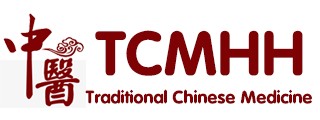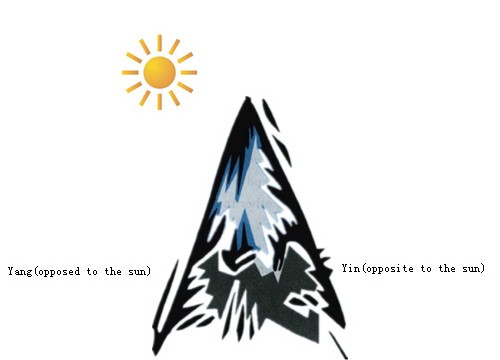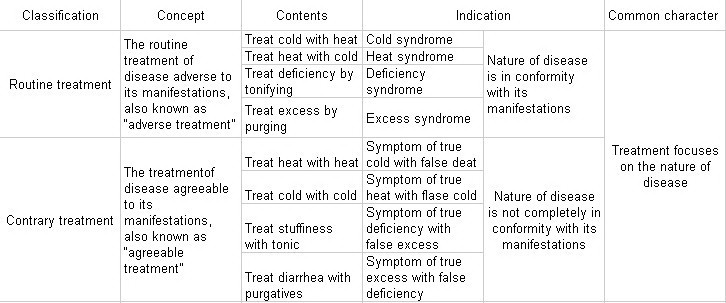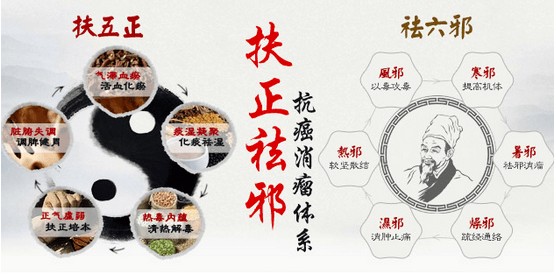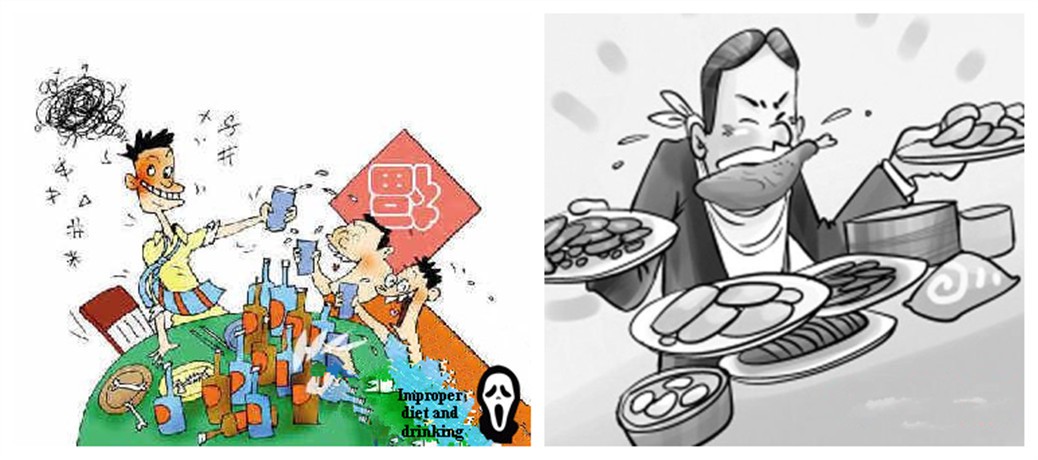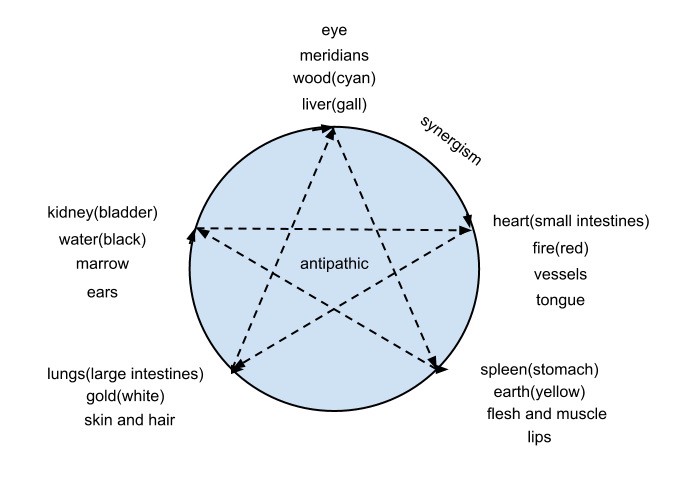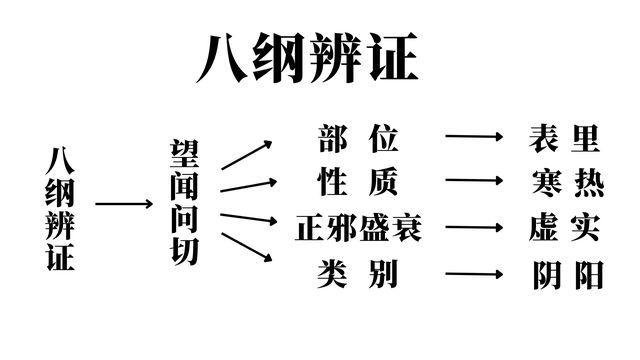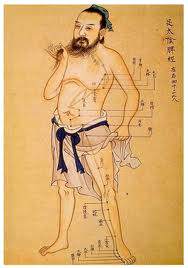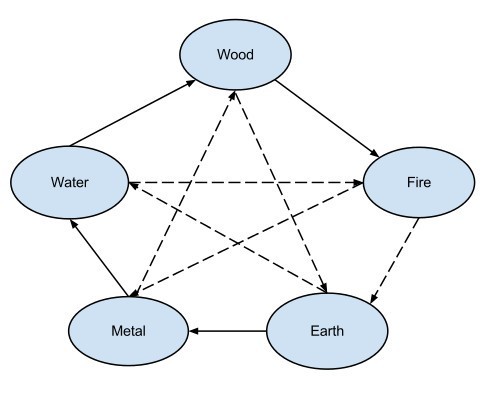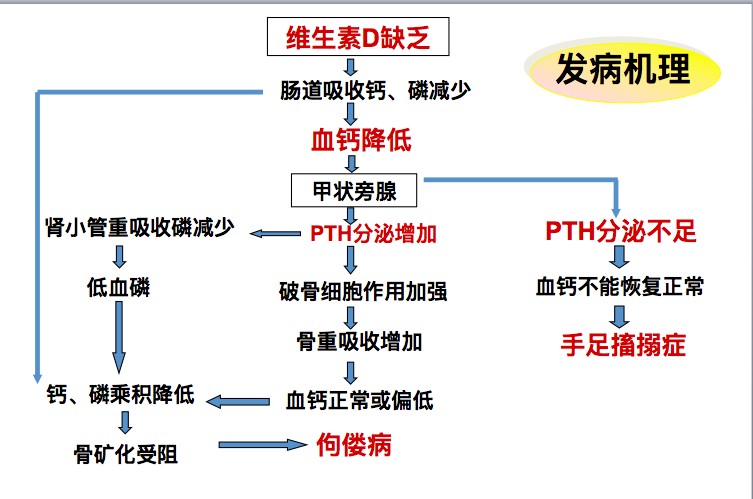
Pathogenesis studies how pathogenic factors affect the human body and cause disease as well as how disease develops and changes.
Disease means the damage of health. TCM believes that the healthy state implies the balance of yin and yang, the manifestation of which is high coordination and unity between the viscera, the meridians, qi, blood and body fluid as well as the body and the external environment. If such a state of high coordination and unity is broken by various pathogenic factors, disease will be caused. The occurrence of disease is actually concerned with pathogenic factors and healthy qi (body resistance). Besides, constitution is also an important factor responsible for the occurrence of disease.
Occurrence of disease and the relationship between pathogenic factors and the healthy qi
The occurrence of disease is a very complicated process of mutual struggle between pathogenic factors and the healthy qi.
1. Deficiency of healthy qi and invasion of pathogenic factors: two important aspects of the occurrence of disease
The healthy qi, one kind of qi that constitutes the body and maintains life activities, exists in all the internal organs and meridians and ensures their normal functions. When pathogenic factors attack the body, healthy qi fights against pathogenic factors and protects the body. That is why it is literarily called "righteous qi" in TCM.
Only when healthy qi is superabundant can it fight against pathogenic factors. The state of healthy qi is decided by the congenital kidney-qi and the acquired gastrosplenic qi. Since essence, blood, body fluid, yin and yang can transform into each other, they directly influence the state of the healthy qi. If healthy qi is insufficient, the body resistance will be weakened, giving rise to the invasion of pathogenic factors.
Pathogenic factors, the factors that directly disturb the normal physiological functions of the body, include six abnormal climatic factors,pestilence, abnormal changes of the seven emotions, improper diet, overwork, over-rest, phlegm, rheum and stagnant blood, etc.
The occurrence of disease results from invasion of pathogenic factors into the body and struggle between pathogenic factors and the healthy qi. The invasion of pathogenic factors into the body is exclusively caused by insufficiency of the healthy qi. Since pathogenic factors can only attack the body when healthy qi is deficient, they are called "deficient pathogenic factors". The combination of "deficient pathogenic factors";with the deficiency of healthy qi is prerequisite to the occurrence of disease, which is described in Huangdi Neijing as "when two conditions of deficiency combine with each other, pathogenic factors begin to attack the body".
2. The effect of healthy qi and pathogenic factors on the occurrence of disease
Insufficiency of healthy qi and invasion of pathogenic factors are two important elements in causing disease. However, their role in causing disease is different. TCM believes that insufficiency of healthy qi is the intrinsic cause of disease while invasion of pathogenic factors is an important condition for the occurrence of disease.
① Insufficiency of healthy qi: the intrinsic cause of disease
TCM pays great attention to the role of healthy qi in causing disease. It believes that normal visceral functions, superabundance of healthy qi, exuberance of qi and blood, and compactness of the defensive qi will prevent pathogenic factors from invading the body. That is why Huangdi Neijing says that "with sufficient healthy qi inside the body, pathogenic factors will have no way to invade the body". Only when healthy qi becomes deficient and the defensive qi is weakened can pathogenic factors invade the body, leading to disorder of yin and yang in the body, disturbance of the visceral functions and occurrence of disease. That is why Huangdi Neijing says that "if pathogenic factors invade the body,qi in the body must be deficient. " Obviously TCM emphasizes the role of healthy qi in causing disease.
Insufficiency of healthy qi is responsible for invasion of pathogenic factors into the body. However, insufficiency of healthy qi manifests in different ways, including general insufficiency and local insufficiency as well as constant insufficiency and temporary insufficiency. General insufficiency usually leads to general disease or transmission of pathogenic factors from local region to other areas. Local insufficiency leads to local disease that will not be transmitted to other areas. Constant insufficiency is usually marked by weak constitution that gives rise to frequent invasion of pathogenic factors and frequent occurrence of disease. Temporary insufficiency is usually due to fatigue, hunger, mental impairment, sexual intercourse, menstruation and labor, though the constitution is usually strong.
Pathological changes may vary due to different degrees of insufficiency of healthy qi and invasion of pathogenic factors. Generally speaking, pathological changes are serious if insufficiency of healthy qi is severe and pathological changes are mild if insufficiency of healthy qi is light. The state of pathological changes is related to the struggle between healthy qi and pathogenic factors. If insufficiency of healthy qi is severe,it will be weak in fighting against pathogenic factors, leading to deficiency syndrome or syndrome of deficiency mingled with excess. If insufficiency of healthy qi is not very serious, it will be strong enough to fight against pathogenic factors, usually leading to excess syndrome due to severe struggle between healthy qi and pathogenic factors.
② Invasion of pathogenic factors: an important condition for the occurrence of disease
Apart from emphasizing the role of healthy qi in causing disease, TCM also pays great attention to the role of pathogenic factors. Generally speaking, people with insufficient healthy qi only have clinical symptoms when they have been attacked by pathogenic factors. Pathogenic factors may dominate the occurrence of disease under certain conditions, such as high temperature, high-pressure electric current, chemical poison, wound caused by gun and bite by poisonous snake, etc. Take pestilence for example. It is also an important element in causing disease, usually leading to widely spreading disease. These pathogenic factors are usually hard to avoid, even for those with superabundance of healthy qi. That is why TCM advocates the idea of "avoiding poisonous factors"; in cultivating health.
Constitution and disease
Constitution is closely related to pathogenesis. That is why TCM pays great attention to constitutional factors.
1. The definiation of constitution
Constitution is formed before birth and can be improved after birth. It is stable and also changeable.
Theoretically, constitution is the manifestation of the functional state of the internal organs, demonstrating the condition of qi, blood, yin and yang in the body. The body resistance in fighting against pathogenic factors is the specific manifestation of constitution in pathogenesis.
Temperament, a concept related to constitution, is a special response of constitution in psychology. Different constitution pairs with different temperament and vice versa.
2. The formation of constitution
Congenital essence is the base of constitution and decides the state of constitution. If constitution is different, its susceptibility to invasion of pathogenic factors is also different. Many hereditary or familial diseases all are related to the constitution of parents and their illness. Besides, the maternal nursing and care during pregnancy exerts great effect on the constitution of fetus.
After birth, the base of constitution is fixed and usually unchangeable. In this sense, the congenital base of constitution influences the whole life of a person. However, the living state after birth also influences constitution. TCM holds that the cultivation of health after birth can accumulate essence to improve constitution, making strong constitution stronger and weak constitution better. On the contrary, lack of proper cultivation of health after birth may make strong constitution weaker and weak constitution worse or fatal. Of course the change of constitution is a slow process.
Specific immunity obtained from illness or vaccination is an important way to develop a certain kind of special constitution.
3. The classification of constitution
Constitution varies from person to person and the study of such a variation is helpful for expounding pathogenesis.
Constitution is generally classified into two categories: strong constitution and weak constitution. For thoroughly explaining the pathogenesis of various diseases, there are different ways to divide constitution in TCM, generally including classification according to yin and yang theory, classification according to five elements theory, classification according to the viscera, classification according to qi, blood and body fluid, and synthetic classification. These ways to classify constitution are complicated, the following is a brief introduction to some commonly encountered types of constitution.
① Constitution with superabundant yang
Superabundance of yang produces heat. So this type of constitution is marked by reddish complexion, sonorous voice, warm hands and feet, dry stool, slightly yellowish urine, tolerance to cold and intolerance to heat as well as slightly rapid pulse. This kind of syndrome can be further divided into specific types according to location of heat in different viscera, such as up-flaming of heart-fire, hyperactivity of liver-yang and exuberant fire in the heart and the liver, etc.
② Constitution with superabundant yin
Superabundant yin produces cold. So this type of constitution is marked by bluish complexion, low voice, cold hands and feet, soft stool, clear urine, tolerance to heat and intolerance to cold as well as slightly slow pulse, etc. This kind of syndrome can be further divided into specific types according to location of cold in different viscera, such as retention of cold in the lung, stagnation of cold in the liver meridian and accumulation of cold in the spleen and stomach, etc.
③ Constitution with deficiency of yang
Deficiency of yang generates cold. So this type of constitution is marked by whitish complexion, cold feet and hands, spontaneous sweating, impotence, diarrhea, profuse clear urine and deep-slow pulse. This kind of syndrome can be further divided into specific types according to location of cold in different viscera, such as insufficiency of heart-yang, insufficiency of spleen-yang, insufficiency of kidney-yang (decline of fire in life-gate), etc.
④ Constitution with deficiency of yin
Deficiency of yin means insufficiency of yin-essence and deficiency of yin generates heat. So this type of constitution is marked by reddish cheeks, emaciation, feverish sensation in the soles and palms, dysphoria, insomma, night sweating, seminal emission, dry stool, scanty brownish urine and thin-rapid pulse, etc. This kind of syndrome can be further divided into specific types according to location of heat in different viscera, such as insufficiency of heart-yin, insufficiency of liver-yin, insufficiency of lung-yin, insufficiency of spleen-yin and insufficiency of kidney-yin, etc.
⑤ Constitution with deficiency of qi
Deficiency of qi means insufficiency of the primordial qi and deficiency of qi leads to hypofunction of the viscera. So this type of constitution is marked by sallow complexion, dispiritedness, lassitude, low voice, poor appetite and weak pulse, etc. This kind of syndrome can be further divided into specific types according to the viscera involved, such as insufficiency of heart-qi, insufficiency of lung-qi, insufficiency of spleen-qi and insufficiency of kidney-qi, etc.
⑥ Constitution with deficiency of blood
Blood deficiency leads to malnutrition of the viscera. So this type of constitution is marked by pale complexion, dizziness, numbness of limbs, weakness of limbs, pale lips and nails, insomnia, dreaminess, scanty light-colored menses, light-colored tongue and thin-weak pulse, etc. This kind of syndrome can be further divided into specific types according to the viscera involved, such as insufficiency of heart-blood and insufficiency of liver-blood, etc.
⑦ Constitution with exuberant dampness
Exuberant dampness is caused by metabolic disturbance of body fluid due to prolonged living in humid areas and inhibited transformation of qi. The usual symptoms are obesity, dizziness, chest oppression, profuse phlegm, frequent nausea, poor appetite, mucous stool, profuse menorrhea, thick-greasy tongue coating and taut-slippery pulse, etc. This kind syndrome can be further divided into specific types according to the viscera involved, such as accumulation of phlegm-dampness in the lung, phlegm-dampness encumbering the spleen, phlegm-turbidity disturbing the heart and phlegm blocking the meridians, etc.
⑧ Constitution with stagnant blood
Constitution with stagnant blood means that internal retention of blood stasis due to unsmooth circulation of blood. The usual symptoms are grayish complexion, heaviness or pain of the head and limbs, or mass in the body, irregular menstruation or dysmenorrhea or purplish menses with blood clot, purplish tongue or tongue with petechia, thin and unsmooth pulse, etc. This kind of syndrome can be further divided into specific types according to the viscera involved, such as blockage of the liver collaterals, blockage of the heart meridian and blockage of the uterus, etc.
The types of constitution sometimes are mingled with each other, such as constitution with superabundant yin mingled with deficiency of yang, constitution with deficiency of yang mingled with deficiency of qi, constitution with exuberant dampness mingled with blood stasis, etc.
4. The influence of constitution on disease
Generally speaking, people with strong constitution infrequently contract disease because of superabundance of healthy qi; people with weak constitution frequently contract disease because of insufficiency of healthy qi. However, different types of constitution usually exert different effects on the occurrence of disease.
① Different types of constitution and different levels of susceptibility to invasion of pathogenic factors
Different types of constitution are subject to invasion of different pathogenic factors. For example, people with superabundant yang and deficient yin are frequently attacked by wind and heat, but infrequently attacked by cold and dampness, people with superabundant yin and deficient yang are frequently attacked by cold and dampness, but infrequently attacked by wind and heat; people with insufficient body fluid and blood are frequently attacked by dryness, but infrequently attacked by dampness; people with exuberant phlegm and dampness are frequently attacked by dampness, but infrequently attacked by dryness.
② Different types of constitution and the principle of pathogenesis
The location and nature of disease after the invasion of pathogenic factors are usually decided by the types of constitution. In people with frequent weak constitution, disease tends to transmit to the weak areas and develop into special pathological changes. For example, spleen deficiency tends to lead to direct invasion of pathogenic factors into the spleen meridian and bring on spleen disease; lung deficiency tends to lead to direct invasion of pathogenic factors into the lung meridian and bring on lung disease; liver deficiency tends to lead to direct invasion of pathogenic factors into the liver meridian and bring on liver disease; heart deficiency tends to lead to direct invasion of pathogenic factors into the heart meridian and bring on heart disease; kidney deficiency tends to lead to direct invasion of pathogenic factors into the kidney meridian and bring on kidney disease; superficial deficiency tends to lead to external lingering of pathogenic factors and bring on external syndrome; meridian deficiency tends to lead to transmission of pathogenic factors along the meridians and bring on disorder of the meridians, etc.
The types of constitution decide the nature of disease. For example, the constitution with superabundant yang tends to develop heat syndrome after being attacked by pathogenic heat and even by pathogenic wind, cold and dampness which will transfer into heat after invasion into the body; the constitution with deficiency of yin tends to develop cold syndrome after being attacked by pathogenic factors; the constitution with spleen deficiency tends to develop dampness syndrome after being attacked by pathogenic factors. Thus the invasion of pathogenic factors in the same environment will lead to diseases of different nature because of difference in constitution. Such a phenomenon in TCM is called "transformation according to constitution" or "transformation of nature of disease".
③ Different types of temperament and different levels of susceptibility to the invasion of pathogenic factors
Temperament is a special psychological reaction of constitution. Different types of temperament lead to different levels of susceptibility to the invasion of pathogenic factors. This phenomenon is the same as that of different types of constitution leading to different levels of susceptibility to the invasion of pathogenic factors. Generally speaking, the temperament with abundance of yang is easy to be attacked by wind and heat and difficult to be attacked by cold and dampness; the temperament with abundance of yin is easy to be attacked by cold and dampness and difficult to be attacked by wind and heat.
Huangdi Neijing also holds that braveness and timidity also affect the occurrence of disease, After being attacked by pathogenic factors, people with brave temperament are characterized by rapid flow of qi and blood, no retention and quick elimination of pathogenic factors; people with timid temperament are marked by slow flow of qi and blood and frequent retention of pathogenic factors, leading to occurrence of disease.
